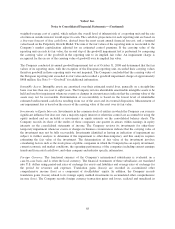Yahoo 2008 Annual Report Download - page 72
Download and view the complete annual report
Please find page 72 of the 2008 Yahoo annual report below. You can navigate through the pages in the report by either clicking on the pages listed below, or by using the keyword search tool below to find specific information within the annual report.Yahoo! Inc.
Notes to Consolidated Financial Statements—(Continued)
Company records a valuation allowance against particular deferred income tax assets if it is more likely than not
that those assets will not be realized. The provision for income taxes comprises the Company’s current tax
liability and change in deferred income tax assets and liabilities.
Significant judgment is required in evaluating the Company’s uncertain tax positions and determining its
provision for income taxes. Effective January 1, 2007, the Company adopted the provisions of FASB
Interpretation No. 48, “Accounting for Uncertainty in Income Taxes” (“FIN 48”). The Company establishes
reserves for tax-related uncertainties based on estimates of whether, and the extent to which, additional taxes will
be due. These reserves are established when the Company believes that certain positions might be challenged
despite its belief that its tax return positions are in accordance with applicable tax laws. The Company adjusts
these reserves in light of changing facts and circumstances, such as the closing of a tax audit, new tax legislation,
or the change of an estimate. To the extent that the final tax outcome of these matters is different than the
amounts recorded, such differences will affect the provision for income taxes in the period in which such
determination is made. The provision for income taxes includes the effect of reserve provisions and changes to
reserves that are considered appropriate, as well as the related net interest and penalties. See Note 10—“Income
Taxes” for additional information.
Comprehensive Income. Comprehensive income consists of two components, net income and other
comprehensive income (loss). Other comprehensive income (loss) refers to gains and losses that under GAAP are
recorded as an element of stockholders’ equity but are excluded from net income. The Company’s other
comprehensive income (loss) is comprised of foreign currency translation adjustments and unrealized gains and
losses on marketable debt and equity securities categorized as available-for-sale, as well as the Company’s share
of its equity investees’ foreign currency translation adjustments.
Cash and Cash Equivalents, Short and Long-Term Marketable Debt Securities. The Company invests its excess
cash in money market funds and liquid debt instruments of the U.S. Government and its agencies, state
municipalities, and in high-quality corporate issuers which are classified as marketable debt securities. All
investments with an original maturity of three months or less are considered cash equivalents. Investments with
effective maturities of less than 12 months from the balance sheet date are classified as current assets.
Investments with effective maturities greater than 12 months from the balance sheet date are classified as long-
term assets.
The Company’s marketable debt securities are classified as available-for-sale and are reported at fair value, with
unrealized gains and losses, net of tax, recorded in accumulated other comprehensive income (loss). Realized
gains or losses and declines in value judged to be other-than-temporary, if any, on available-for-sale securities
are reported in other income, net. The Company evaluates the investments periodically for possible other-than-
temporary impairment and reviews factors such as the length of time and extent to which fair value has been
below cost basis, the financial condition of the issuer and the Company’s ability and intent to hold the investment
for a period of time which may be sufficient for anticipated recovery in market value. If appropriate, the
Company records impairment charges equal to the amount that the carrying value of its available-for-sale
securities exceeds the estimated fair market value of the securities as of the evaluation date. In computing
realized gains and losses on available-for-sale securities, the Company determines cost based on amounts paid,
including direct costs such as commissions to acquire the security, using the specific identification method.
During the years ended December 31, 2006, 2007, and 2008, gross realized gains and losses on available-for-sale
debt securities were not material.
Concentration of Risk. Financial instruments that potentially subject the Company to significant concentration of
credit risk consist primarily of cash, cash equivalents, marketable debt securities, and accounts receivable. The
Company’s cash and debt investment policy and strategy attempt primarily to preserve capital and meet liquidity
66
























